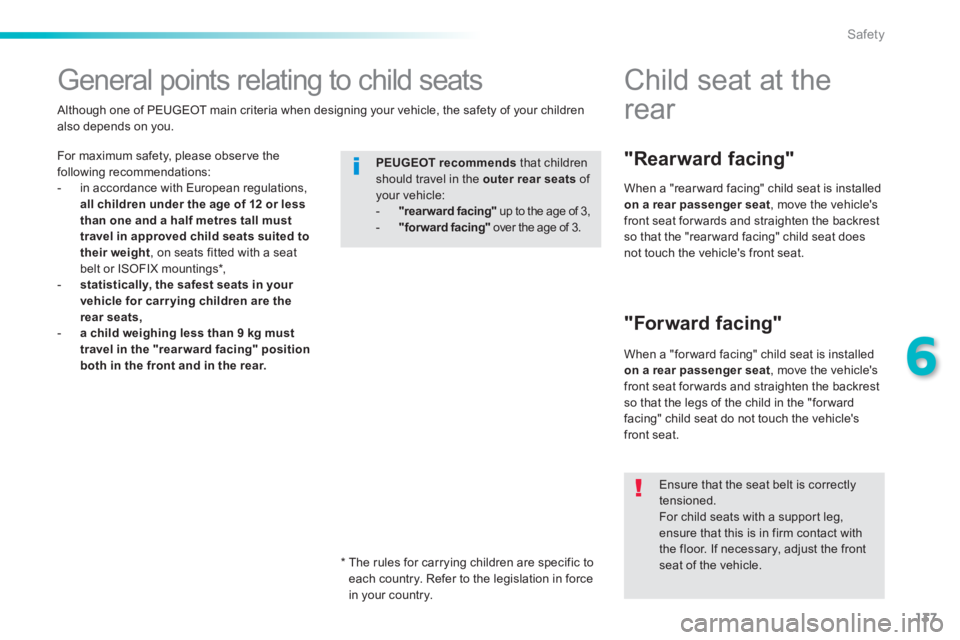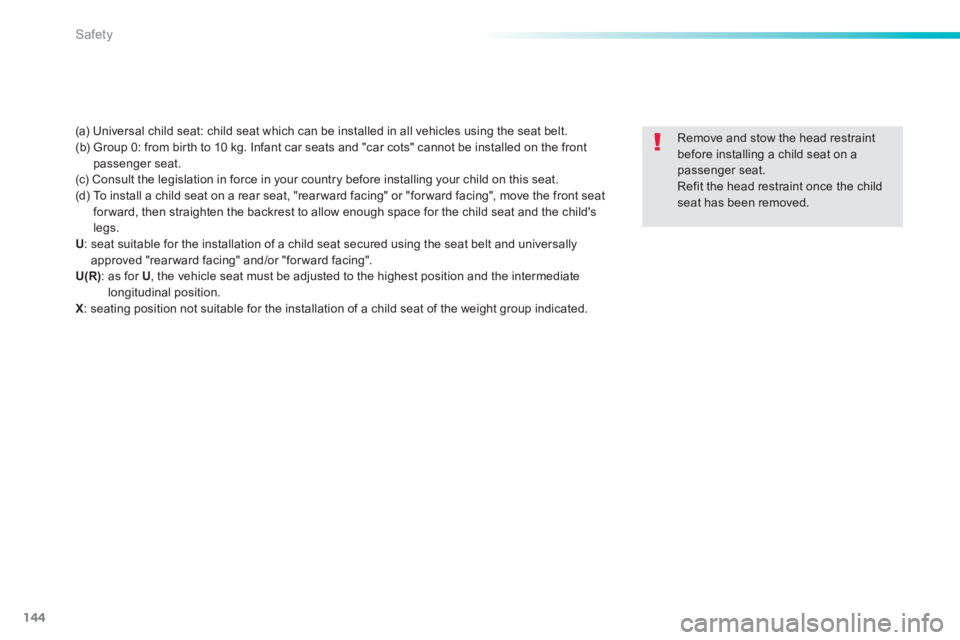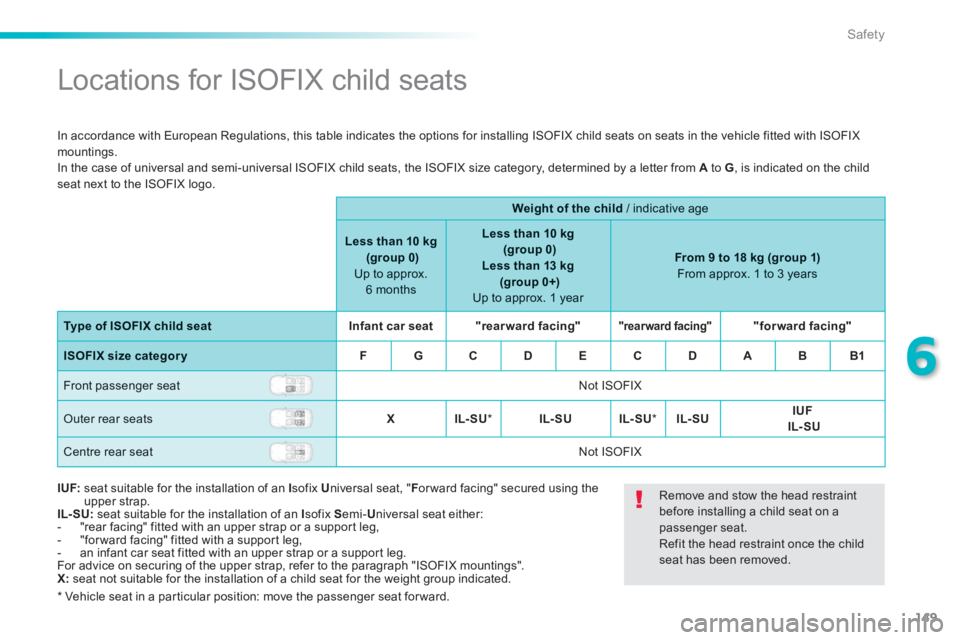2013.5 PEUGEOT 2008 weight
[x] Cancel search: weightPage 5 of 336

.
.
Contents
Direction indicators 123
Hazard warning lamps 123
Emergency or assistance call 124
H or n 124
ESC system 125
Grip control 128
Front seat belts 130
Airbags 133
Child seats 137
Deactivating the passenger's front airbag 139
ISOFIX child seats 146
Child lock 150
Safety
Temporary puncture repair kit 151
Changing a wheel 157
Snow chains 164
Changing a bulb 165
Changing a fuse 172
Battery 178
Electrical energy economy mode 181
Changing a wiper blade 182
Towing the vehicle 183
Towing a trailer 185
Fitting roof bars 187
Advice on care and maintenance 187
Accessories 188
Practical information
Bonnet 191
Petrol engines 192
Diesel engines 193
Fuel tank 194
Misfuel prevention (Diesel) 196
Running out of fuel (Diesel) 198
Checking levels 199
Checks 202
Checks
Petrol engines 204
Petrol weights 205
Diesel engines 206
Diesel weights 208
Dimensions 211
Identifi cation markings 212
Technical data
Emergency or assistance 213
Touch screen 215
Audio system / Bluetooth 277
Audio system 303
Audio equipment and telematics
Visual search
Alphabetical index
Page 38 of 336

36
Monitoring
Service overdue
For 7 seconds after the ignition is switched on, the spanner flashes to indicate that the service must be carried out as soon as possible. Example: the service is overdue by 186 miles (3 0 0 k m). For 7 seconds after the ignition is switched on, the screen indicates:
The distance remaining may be weighted by the time factor, depending on the driving conditions. Therefore, the spanner may also come on if you have exceeded the period
since the last service, indicated in the servicing and warranty booklet .
Following this operation, if you wish to disconnect the battery, lock the vehicle and wait at least five minutes for the zero reset to be taken into account.
Service indicator zero reset
After each service, the service indicator must be reset to zero. The procedure for resetting to zero is as follows: switch off the ignition, press and hold the trip distance recorder zero reset button, switch on the ignition; the distance recorder display begins a countdown, when the display indicates "=0" , release the button; the spanner disappears.
Retrieving the service information
You can access the service information at any time. Press the trip distance recorder zero reset button. The service information is displayed for a few seconds, then disappears.
7 seconds after the ignition is switched on, the distance recorder resumes its normal operation. The spanner remains on .
Page 139 of 336

137
6
Safety
General points relating to child seats
For maximum safety, please observe the following recommendations: - in accordance with European regulations, all children under the age of 12 or less than one and a half metres tall must travel in approved child seats suited to their weight , on seats fitted with a seat belt or ISOFIX mountings * , - statistically, the safest seats in your vehicle for carr ying children are the rear seats, - a child weighing less than 9 kg must travel in the "rearward facing" position both in the front and in the rear.
PEUGEOT recommends that children should travel in the outer outer outerrear seats of your vehicle: - "rearward facing" up to the age of 3, - "forward facing" over the age of 3.
Although one of PEUGEOT main criteria when designing your vehicle, the safety of your children also depends on you.
* The rules for carrying children are specific to each country. Refer to the legislation in force in your country.
Child seat at the
rear
"Rearward facing"
"Forward facing"
When a "rear ward facing" child seat is installed on a rear passenger seat , move the vehicle's front seat for wards and straighten the backrest so that the "rear ward facing" child seat does not touch the vehicle's front seat.
When a "for ward facing" child seat is installed on a rear passenger seat , move the vehicle's front seat for wards and straighten the backrest so that the legs of the child in the "for ward facing" child seat do not touch the vehicle's
front seat.
Ensure that the seat belt is correctly tensioned. For child seats with a support leg, ensure that this is in firm contact with the floor. If necessary, adjust the front seat of the vehicle.
Page 145 of 336

143
6
Safety
Locations for child seats secured with the seat belt
Weight of the child / indicative age Weight of the child / indicative age Weight of the child /
SeatLess than 13 kg (groups 0 (b) and 0+) Up to 1 year approx
From 9 to 18 kg (group 1) From 1 to 3 years approx
From 15 to 25 kg (group 2) From 3 to 6 years approx
From 22 to 36 kg (group 3) From 6 to 10 years approx
Front passenger seat (c)
- with height adjustment U(R)U(R)U(R)U(R)
- without height adjustment UUUU
Outer rear seats (d) UUUU
Centre rear seat XXXX
In accordance with the European regulation, this table indicates the options for the installation of child seats secured using the seat belt and universally approved (a) in relation to the weight of the child and the seat in the vehicle.
Page 146 of 336

144
Safety
(a) Universal child seat: child seat which can be installed in all vehicles using the seat belt. (b) Group 0: from birth to 10 kg. Infant car seats and "car cots" cannot be installed on the front passenger seat. (c) Consult the legislation in force in your country before installing your child on this seat. (d) To install a child seat on a rear seat, "rear ward facing" or "for ward facing", move the front seat for ward, then straighten the backrest to allow enough space for the child seat and the child's legs. U : seat suitable for the installation of a child seat secured using the seat belt and universally approved "rearward facing" and/or "forward facing". U(R) : as for U , the vehicle seat must be adjusted to the highest position and the intermediate longitudinal position. X : seating position not suitable for the installation of a child seat of the weight group indicated.
Remove and stow the head restraint before installing a child seat on a passenger seat. Refit the head restraint once the child seat has been removed.
Page 151 of 336

149
6
Safety
Locations for ISOFIX child seats
In accordance with European Regulations, this table indicates the options for installing ISOFIX child seats on seats in the vehicle fitted with ISOFIX mountings. In the case of universal and semi-universal ISOFIX child seats, the ISOFIX size category, determined by a letter from A to G , is indicated on the child seat next to the ISOFIX logo.
Weight of the child / indicative age
Less than 10 kg (group 0) Up to approx. 6 months
Less than 10 kg (group 0) Less than 13 kg (group 0+) Up to approx. 1 year
From 9 to 18 kg (group 1) From approx. 1 to 3 years
Type of ISOFIX child seatInfant car seat"rearward facing""rearward facing""forward facing"
ISOFIX size categor yFGCDECDABB1
Front passenger seat Not ISOFIX
Outer rear seats XIL- SU * IL- SUIL- SU * IL- SUIUF IL- SU
Centre rear seat Not ISOFIX
I UF: seat suitable for the installation of an I sofix U niversal seat, " F or ward facing" secured using the upper strap. IL- SU: seat suitable for the installation of an I sofix S emi- U niversal seat either: - "rear facing" fitted with an upper strap or a support leg, - "for ward facing" fitted with a support leg, - an infant car seat fitted with an upper strap or a support leg. For advice on securing of the upper strap, refer to the paragraph "ISOFIX mountings". X: seat not suitable for the installation of a child seat for the weight group indicated.
* Vehicle seat in a particular position: move the passenger seat for ward.
Remove and stow the head restraint before installing a child seat on a passenger seat. Refit the head restraint once the child seat has been removed.
Page 185 of 336

183
7
Practical information
Towing the vehicle
Access to the tools
The towing eye is installed in the boot under the floor. To gain access to it: open the boot, lift the floor and remove it, remove the towing eye from the holder.
General recommendations
Observe the legislation in force in your country. Ensure that the weight of the towing vehicle is higher than that of the towed vehicle. The driver must remain at the wheel of the towed vehicle and must have a valid driving licence. When towing a vehicle with all four wheels on the ground, always use an approved towing bar; rope and straps are prohibited. The towing vehicle must move off gently.
When towing a vehicle with the engine off, there is no longer any power assistance for braking or steering. In the following cases, you must always call on a professional recovery service: - vehicle broken down on a motor way or fast road, - four-wheel drive vehicle, - when it is not possible to put the gearbox into neutral, unlock the steering, or release the parking brake, - towing with only two wheels on the ground, - where there is no approved towing bar available...
Procedure for having your vehicle towed or for towing another vehicle using a removable towing eye.
Page 188 of 336

186
Practical information
Driving advice
Distribution of loads
Distribute the load in the trailer so that the heaviest items are as close as possible to the axle and the nose weight approaches the maximum permitted without exceeding it.
Air density decreases with altitude, thus reducing engine performance. Above1 000 metres, the maximum towed load must be reduced by 10 % for every 1 000 metres of altitude.
Side wind
Take into account the increased sensitivity to side wind.
Cooling
Towing a trailer on a slope increases the temperature of the coolant. As the fan is electrically controlled, its cooling capacity is not dependent on the engine speed.
To lower the engine speed, reduce your speed. The maximum towed load on a long incline depends on the gradient and the ambient temperature. In all cases, keep a check on the coolant temperature.
If the warning lamp and the STOP warning lamp come on, stop the vehicle and switch off the engine as soon as possible.
Braking
Towing a trailer increases the braking distance. To avoid overheating of the brakes on a long mountain type of descent, the use of engine braking is recommended.
Ty r e s
Check the tyre pressures of the towing vehicle and of the trailer, observing the recommended pressures.
Lighting
Check the electrical lighting and signalling on the trailer.
The rear parking sensors will be deactivated automatically if a genuine PEUGEOT towbar is used.
Refer to the "Technical data" section for details of the weights and towed loads which apply to your vehicle.